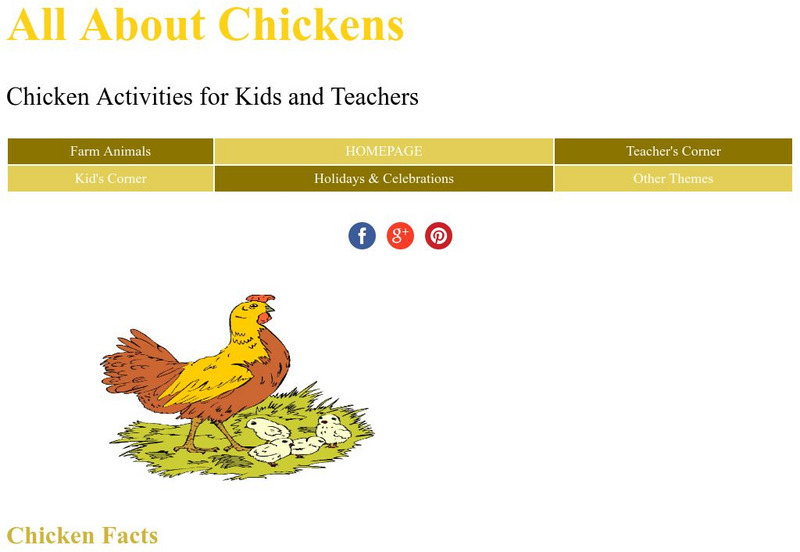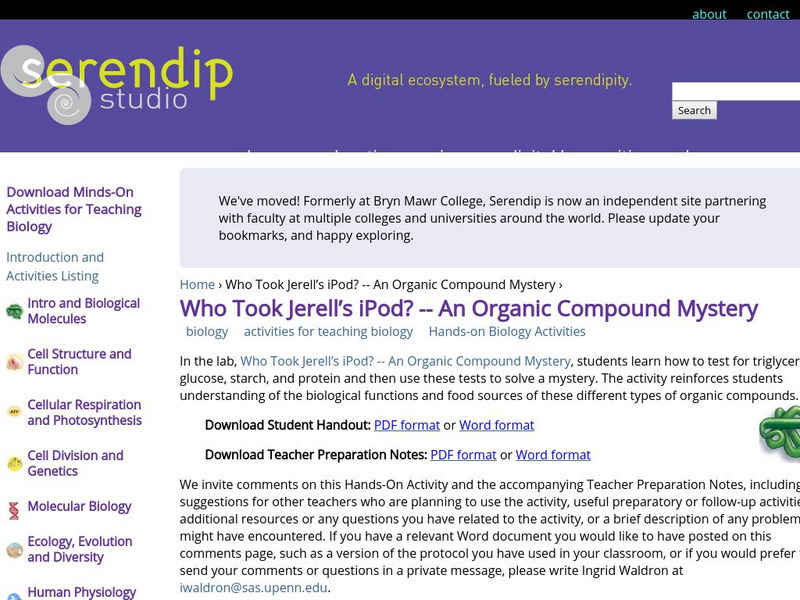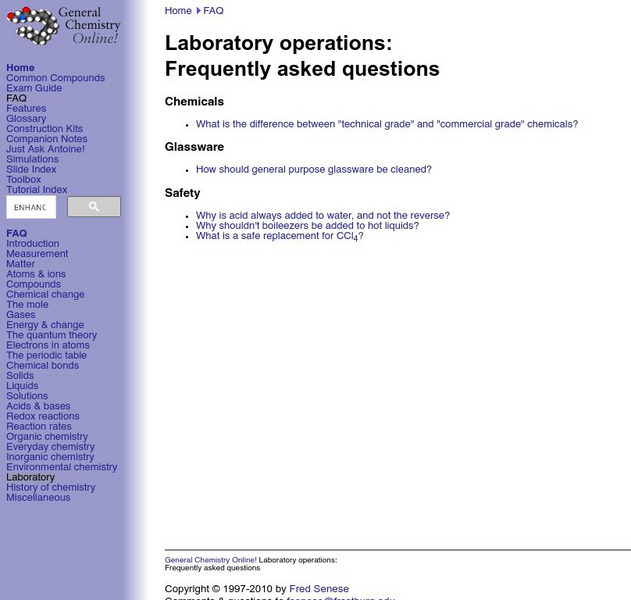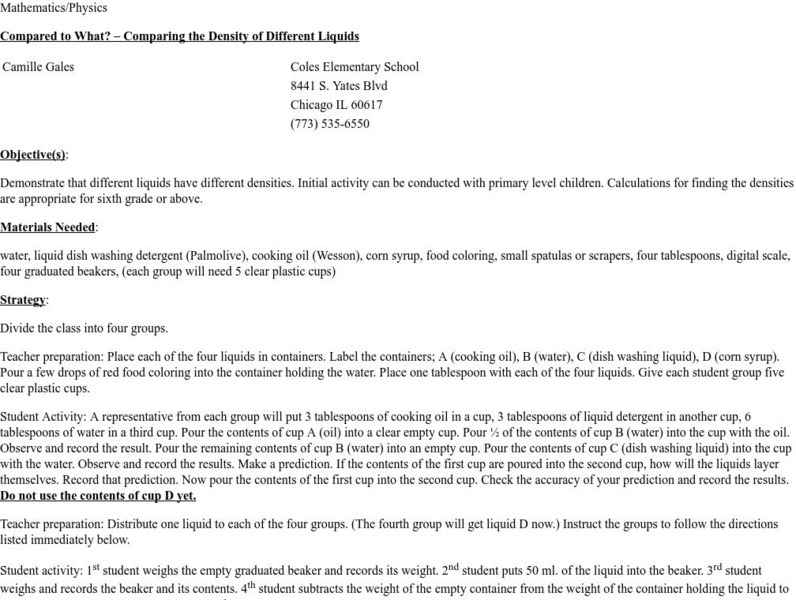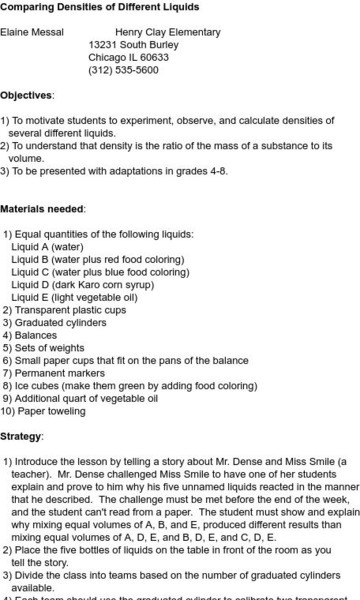Physics Classroom
The Physics Classroom: Inertia and Mass
This is part of a lesson on Newton's Laws of Motion that focuses on inertia and mass. It restates Newton's first law of motion. The lesson also gives a helpful visual description concerning friction.
Other
Kiddy House: All About Chickens for Kids and Teachers
This comprehensive resource features everything you want to know about chickens. Students and teachers will "cluck" when they explore this site.
Bryn Mawr College
Serendip: Who Took Jerell's I Pod? An Organic Compound Mystery
Brief text summary of what young scholars learn in the Who Took Jerell's iPod? lab along with links to download Student Handouts and Teacher Preparation Notes in PDF or Word formats. Students are challenged to solve a mystery by testing...
PBS
Pbs Kids: Conduction Countdown
PBS offers an experiment that kids can do at home to learn more about heat conduction and how it works.
PBS
Pbs Kids: Dragonfly Tv Do It: Grow a Crystal
This PBS Kids site teaches students about crystals and includes an activity that shows how to make sparkling gems at home.
PBS
Pbs Kids: Dragonfly Tv Do It: Leaf Me Alone!
How do leaves breathe? PBS site explores how plants breathe and sustain life.
PBS
Pbs Kids: Dragonfly Tv: Know How? Cutting a Rock
How can you cut a rock without a saw? Is it possible? PBS site invites you to come along with Mike and Victor to find out.
Frostburg State University
General Chemistry Online: Laboratory Operations Faq
A narrow list of questions about technicalities with chemistry labs. Find out the how to properly clean glassware and why acid should always be added to water in that order.
University of Missouri
Microbes in Action: "There's Something Fishy": The Nitrogen Cycle
An opportunity for students to experience the nitrogen cycle through observing daily changes in an aquarium. Students test the level of three nitrogen compounds to understand the process of nitrification. Lesson plan gives a lab...
University of Missouri
Microbes in Action: Classroom Activities: A Swell Lab: Yeast Fermentation [Pdf]
This two-day experiment uses different concentrations of sugar to study the rate of fermentation. Students observe the rate of carbon dioxide gas produced by yeast to infer the rate of fermentation. Lesson plan gives a lab procedure,...
University of Missouri
Microbes in Action: Classroom Activities: Simple Staining of Microbes [Pdf]
With this simple stain, students can observe the shape of yeast and bacteria under the microscope. Lesson plan gives a lab procedure, teacher instructions, points for discussion, and additional activities. Lab does require the purchase...
Bryn Mawr College
Serendip: Is Yeast Alive?
Brief text summary of what students learn in the Is Yeast Alive? Lab, along with links to download Student Handouts and Teacher Preparation Notes in PDF or Word formats. Characteristics of life are addressed and metabolism and the...
Bryn Mawr College
Serendip: Diffusion Across a Selectively Permeable Membrane
Brief text summary of what students learn in the Diffusion across a Selectively Permeable Membrane lab, along with links to download Student Handouts and Teacher Preparation Notes in PDF or Word formats. Main teaching points include...
Other
Alliance to Save Energy: Educator Lesson Plans
A series of teacher lesson plans for various grade levels. Topics pertain to insulation (among other things) and other energy conservation and energy efficiency topics. Can be easily adapted for a student project or lab investigation.
Alabama Learning Exchange
Alex: Amazing Adaptations Probing Pinnipeds
This is a technology-rich, hands-on science experiment exploring the world of pinniped adaptations using a digital probe as a data collection device.
Hunkins Experiments
Hunkin's Experiments: Surface Tension
Hunkin's Experiments is a group of simple cartoon illustrations of scientific principles. Some would work well in the classroom, but others have little value beyond entertaining students. All of the projects are easy to do. These two are...
Hunkins Experiments
Hunkin's Experiments: See if a Ring Is Pure Gold
Hunkin's Experiments is a group of simple cartoon illustrations of scientific principles. Some would work well in the classroom, but others have little value beyond entertaining students. All of the projects are easy to do. This one...
Science and Mathematics Initiative for Learning Enhancement (SMILE)
Smile: Comparing Liquid Density
Because different liquids have different properties, density also differs. In this lesson from the Illinois Institute of Technology, learners will calculate densities of water, dish-washing detergent, cooking oil, and other liquids.
Science and Mathematics Initiative for Learning Enhancement (SMILE)
Smile: Comparing Densities of Different Liquids
This lab experiment has students observe and compare the density of five different liquids while measuring mass and volume.
My Science Site
Forces and Motion [Pdf]
This resource provides reproducibles that aide in student learning of force and motion. Also offers hands-on and cooperative learning activity ideas as well as an ESL/ELD activity. This resource is in PDF form; requires Adobe Reader.
My Science Site
Experiments With Levers [Pdf]
This resource details a cooperative learning activity on experimenting with levers. Offers eight different tests students can engage in. A student data sheet is also provided for students to record their findings. This resource is in PDF...
My Science Site
Bj's Science: Take a Walk! [Pdf]
In this activity students literally walk through this activity calculating acceleration. Also, students calculate speed, graph acceleration, as well as do statistical data analysis. This resource is in PDF form; requires Adobe Reader.
My Science Site
Thinking Fountain: Liquid Layers [Pdf]
Students contrast the densities of oil and water in this lab activity. Can be done in groups or individually. This resource is in PDF form; requires Adobe Reader.
My Science Site
My Science Site: World of Colours [Pdf]
This resource presents a cooperative learning activity where students can enhance their knowledge of light diffraction. This resource is in PDF form; requires Adobe Reader.



